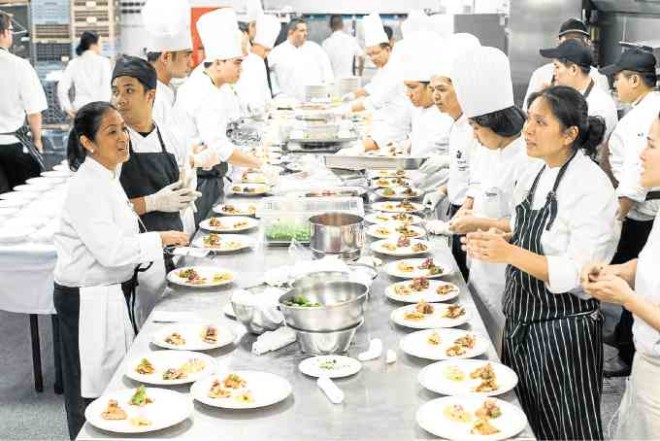
—PHOTOS BY JILSON SECKLER TIU
It sounds like a television show challenge: four chefs, from diverse backgrounds, with different personalities, who have never worked together, have to put together a four-course meal with hors d’oeuvres for 350 people.
This is not amateur hour, though. The four chefs who collaborated at the Unicef Children’s Ball on March 4 at The Peninsula Manila were awarded Asia’s Best Female Chef by the World’s 50 Best Restaurants judges, on consecutive years starting 2013: Lanshu Chen of Le Moût in Taiwan; Bo Songvisava of Bo.Lan in Thailand; Vicky Lau of Tate Dining Room.
The Philippines’ Margarita Forés won the award last year.
If this sounds like arrant name-dropping, it is. But we’ll make an exception for the occasion, the Unicef Children’s Ball which is for a good cause.
Unicef doesn’t have the kind of top-of-mind recognition that it used to enjoy; it feels like a holdover from another era, when the United Nations helped keep the world safe, and helping the underprivileged was everyone’s responsibility. Nowadays it seems to be more the fashion to mock them as subhuman, or to kill them. So, if Unicef is resolutely old-fashioned in its desire to help, it’s a traditionalism I support.
The organizers, as well as UN ambassadors Gary Valenciano, Daphne Oseña-Paez and Anne Curtis gave their services pro bono, as did the four chefs. Despite being from different regions of Asia, all of them share similar creative approaches to food as well as concerns surrounding food: sustainability, supporting local farmers and reducing waste.
Western foundation
The chefs received their culinary education with a Western foundation: French for both Lau and Chen; Italian for Forés; while Songvisava trained in Australia and in London. While Lay and Chen run restaurants that would be listed as French or continental, both are trying to bring a little of their own culture to the strict rigor and, it must be said, insularity of French cuisine.
“But I don’t like the word ‘fusion,’” said Chen. “It’s too vague, it means too many things.”
Lau, at the Tate Dining Room, makes three kinds of stock: the traditional French fond; the Chinese master stock; and a Japanese kombu stock.
Forés, known for making posh pasta accessible as well as catering to heads of state, has become an unlikely but highly knowledgeable ambassador for Philippine food. Though she’s the owner of a number of successful restaurants around Manila, she lists Grace Park, her eclectic, experimental place in Rockwell, as her flagship.
Bo.Lan is a restaurant very much in the vein of David Thompson’s Nahm, where Songvisava trained. She said: “I do try to incorporate new ingredients and techniques, as Thai food has been doing with every new influence that comes. But I don’t feel I can do fusion food, because I haven’t mastered Thai food yet!”
Tight ship
Like all collaboration dinners, it was a delicate dance of give and take among the four chefs. But these dinners are unique and interesting for this very reason. Service was surprisingly prompt and well-oiled; dishes emerged magically from the kitchen and landed on our tables; and then they went on to the next. Only my photographer was allowed access to the kitchens, where the chefs were running a tight, frenzied ship.
Songvisava’s food was very tame compared to her usual fare at Bo.Lan, where you breathe fire with every mouthful, but was no less flavorful.
Forés’ plates of white marlin with burnt coconut cream sauce arrived still piping hot, always a concern with large-scale banqueting; coconut milk and crab fat wait for no one.
The main course was great haunches of wagyu beef, so rare as to be almost raw, with a congee and pickled vegetable sauce and tendons. Chen explained that congee with pickled vegetables was a comfort food in Taiwan (as it is with the Chinese here). The congee was made not with a broth of dried scallops, in the coastal tradition, but with beef bones and tendons, cooked through to lovely fork-tender doneness.
Lau’s dessert was cerebral, intricate, and thankfully light.
Worthwhile cause
I’m not privy to exactly how much was raised by Unicef through this event; regular readers of this space will know that I’ve always been ambivalent about celebrity chefs and the cult surrounding them and their restaurants.
The redeeming value for me is greater cultural exposure and more impetus to make a trip that I would otherwise not take. Le Moût, where Chen serves the same sauce in a more intricate preparation with goose instead of beef, is now firmly pinned as a top destination for me.
Getting a lot of rich people in one room to sign checks is another. I bumped into Dr. Raoul Bermejo, who was at the Unicef table, and it was his enthusiasm for the project, as much as the speeches and children with disabilities who appeared on stage as testimony to the work that they were doing, that convinced me that this cause was worth devoting as much column space as I could muster to.
Like many UN projects, the work is quiet and plodding, and moves slowly, addressing very ordinary problems that shouldn’t be problems—like deafness or poor eyesight or nonfunctioning limbs.
It’s not a cure for cancer; it’s not a silver bullet for disease or social ills.
But if the news this week is anything to go by, the world is a nasty place with some truly dastardly people in it.
It’s a great pleasure to be covering the work of earnest people doing good in an old-fashioned way, and four very talented chefs putting their celebrity to good use. —CONTRIBUTED